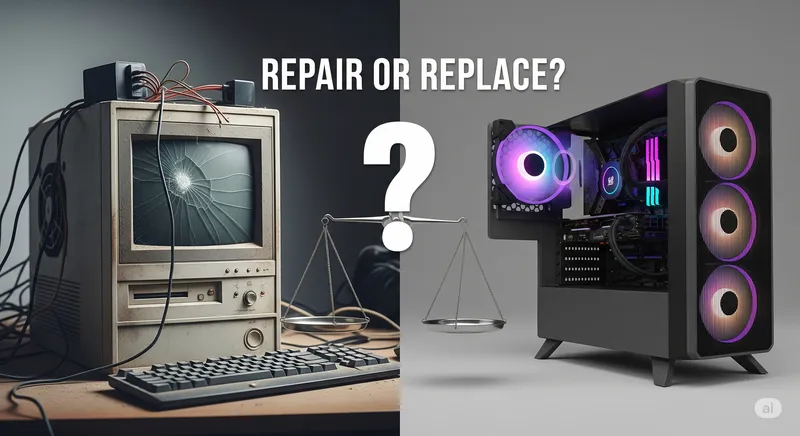Repair or Replace? How to Decide for Your Desktop PC

Your trusty desktop PC has finally hit a major snag. It won’t turn on, the graphics card is failing, or it’s just too slow to handle modern tasks. You’re faced with a classic dilemma: do you invest money into fixing this old machine, or is it time to bite the bullet and buy a new one?
As a repair shop, we obviously believe in the power of repair. But we’re also pragmatists. We want what’s best for our customers in Oceanside and Encinitas, and sometimes, replacement is the smarter long-term financial decision. Our free diagnostic service is designed to give you all the information you need to make this choice confidently.
Here’s the framework we use to help our customers decide.
The “50 Percent Rule”
A widely used guideline in the repair industry is the “50 Percent Rule.”
The rule: If the cost of a repair is more than 50% of the cost of a comparable new computer, you should seriously consider replacing it.
For example, if a new desktop with similar specs costs $800, and your repair bill for a new motherboard and power supply is going to be $450, you’ve crossed that 50% threshold. The repair might still make sense if you’re on a tight budget, but the value proposition starts to diminish.
Key Factors to Consider
The 50% rule is a good start, but other factors come into play.
1. The Age of the Computer
A computer’s age is a major factor.
- 0-3 Years Old: Almost always worth repairing. The core components (CPU, motherboard) are still modern and relevant. A failure is likely an isolated incident (like a faulty power supply).
- 4-6 Years Old: This is the gray area. Repair is often the right choice, especially if it’s a simple fix or a performance-boosting upgrade like an SSD. However, if it needs a major component like a motherboard, you need to weigh the cost carefully.
- 7+ Years Old: Repair becomes much less likely to be cost-effective. The core technology is outdated. A CPU from 2017 simply can’t keep up with modern software demands in the same way a newer one can. A repair at this stage is usually only for simple, cheap fixes or for data recovery purposes.
2. The Nature of the Repair
What actually broke? This is critical.
| Repair Type | Our Typical Recommendation | Why? |
|---|---|---|
| Failed Power Supply (PSU) | Repair. | A relatively inexpensive and common failure. A new PSU can give the machine years of new life. |
| Failed Hard Drive (HDD) | Repair & Upgrade. | This is an opportunity. We’ll replace the failed drive with a much faster SSD. You get a repair and a massive performance boost in one. |
| Failed RAM / Memory | Repair. | RAM is a simple, modular replacement and is not typically expensive. |
| Failed Graphics Card (GPU) | Depends. | If it’s a basic office PC, a cheap replacement GPU is a good value. If it’s a high-end gaming PC, a new GPU can be very expensive—close to the 50% rule. |
| Failed Motherboard/CPU | Lean towards Replace. | This is the “engine” of your PC. It’s often the most expensive repair, and if it fails, it’s a sign the platform is at the end of its life. |
3. Your Use Case
What do you do with your computer?
- Light Use (Email, Web Browsing, Office Docs): An older, repaired computer is perfectly adequate for these tasks. A simple SSD upgrade might be all you need for another 3-4 years.
- Heavy Use (Gaming, Video Editing, Graphic Design): These tasks demand modern processing power. If your 6-year-old gaming PC needs a new motherboard, it’s probably better to put that money towards a new build that can handle the latest games and software.
The PC Repair Center Promise: Honest Advice
When you bring your desktop to our Oceanside or Encinitas location, our job isn’t to sell you the most expensive option. Our job is to give you a clear, honest assessment.
We’ll tell you:
- Exactly what’s wrong.
- What it will cost to fix it.
- How much life you can realistically expect from the machine after the repair.
- Our honest opinion on whether the repair represents good value for your money.
The final decision is always yours, but we’ll make sure it’s an informed one.